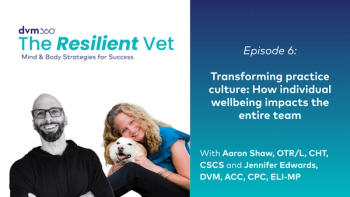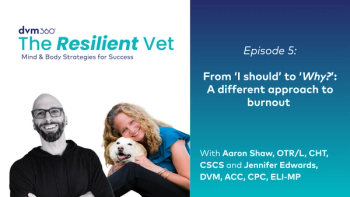
Entering the golden age of veterinary practice (Proceedings)
Our profession has had its ups and downs over the years. We have seen periods of perceived shortages and excesses of practicing veterinarians. We have moved from a profession of mostly male, large animal practitioners to one of mostly female, companion animal practitioners. The human-animal bond has been better understood and developed so that our pets have moved from the barn in the 1950's into our bed by the 1990's.
Our profession has had its ups and downs over the years. We have seen periods of perceived shortages and excesses of practicing veterinarians. We have moved from a profession of mostly male, large animal practitioners to one of mostly female, companion animal practitioners. The human-animal bond has been better understood and developed so that our pets have moved from the barn in the 1950's into our bed by the 1990's.
Today, we have some 80,000 veterinarians in the United States with about 65% in companion animal practice. About 5% of the companion animal practices are corporate practices and 95% are private practices. The average size of private practices is about 2 veterinarians according to AVMA.
Quality of life has become an important issue for practitioners. In the past, many owners and associates worked 50 or more hours a week in addition to being on emergency call. Today, new graduates want to work 40 hours per week or less with no emergency duty at all. Many would like to not work on Saturday and have one or more long weekends per month (Friday through Sunday off). The value of a private life has become more important than income to some people.
Studies from AVMA and AAHA have indicated the more hours worked, the more money is made. There seems to be a disconnect between living a good lifestyle and repayment of debt. The mean educational debt in 2009 was $129,976 as reported by AVMA (JAVMA, 235, Sept. 1, 2009). The mean starting salary for small animal exclusive practice in 2009 was $69,154 (JAVMA, 235, Sept. 1, 2009). The ratio of debt to starting salary is now approaching 2:1. The issue of student debt to starting salary has been discussed by several different groups and associations (AAVMC, AVMA, AAVC, AAHA). The real issue seems to be low income not the level of debt. The level of debt is similar to medical or dental school debt; however the starting salary is not a good measurement of return on investment (ROI). Most of the discussions have centered on starting salaries and not career income potential.
Another factor in the growing student debt issue is the generational differences between today's graduates and graduates of 20-30 years ago. Newer graduates want to work fewer hours and may not be as interested in ownership due to the increased work hours usually required of ownership. This trend seems to cross the gender line as both males and females seem to share this feeling. Veterinary schools have about 80% females in current classes. The gender shift and generational differences seem to make today's graduate more likely to seek work that has controlled hours, nights and weekends free, retirement programs, mentoring programs and benefits programs. These requirements are often not provided in smaller private practices.
In the past 10 years, specialty practices have also entered the picture. This requires the new graduate to continue their training another 3-4 years (Internships/Residency) but allows the potential of a higher income on completion compared to private general practice (JAVMA 234, Jan 1, 2009). However, the additional training may increase the debt load, or at best, delay repayment of student loans. Approximately 43.5% of new graduates are now entering some form of advanced training (JAVMA 235, Sept. 1, 2009).
Specialists have many opportunities for employment including academia, industry, specialty practice or corporate practice. Often, the qualified specialist must make their employment choice based on the level of income due to the large debt repayment obligation. This choice often does not allow the newly trained specialist to be employed by teaching institutions due to the lower salary paid compared to private practice and industry. Therefore, many teaching hospitals are finding it difficult to hire specialists. This has sparked concern over who will teach the new generation of veterinary students and specialists?
Since the introduction of the larger corporate practices starting about 15-20 years ago (i.e. VCA with 470 + practices, Banfield with 750 + practices, and NVA with 120 + practices) the opportunity to have a controlled work week, minimum management duties, retirement plan and benefits has changed the employment picture for both new graduates and specialists. Practices that have one or two veterinarians often do not provide the work schedule flexibility and benefits provided by larger private and corporate practices.
The question that comes up frequently deals with the future of private practices and corporate practices. How will pet insurance affect the level of patient care in the future? Will corporate practice eventually replace private practice as we know it today? Who will buy all the one and two person practices that are now in operation when the owners want to retire? Will there be a balance between corporate and private practice?
I believe there will always be a place for private practice and that they will continue as the dominate form of business in the foreseeable future. However, one person practices will decrease in number and 3, 4, and 5 person practices will increase in number. Some small practices will be lost and others will become consolidated. Both private and corporate practices are here to stay.
Most practicing veterinarians want to be compensated at a higher level of income. The only way to really generate more revenue is to increase the number of patients we see per day and/or increase the average charge per patient. The AVMA-Pfizer study (JAVMA, Jan 15, 2005) reported the most common way veterinarians have increased their income over the past 5 years was to raise fees and increase the average charge per case seen. The average doctor charge per case seen is $117 according to NCVEI. The average number of transactions per full-time-equivalent veterinarian per year is 4,000. This would translate to a gross revenue of $468,000 (4,000 x $117) according to NCVEI. The number of cases a veterinarian sees is about 15 per day (4,000 / 52 weeks / 5 day week). The typical dentist sees 40 per day while the ophthalmologist sees 40-70 cases per day.
If the typical small animal veterinarian were able to increase the number of transactions per year (increase efficiency) from 4,000 to 4,500 and to increase the average doctor charge per case seen (increase quality of services) from $117 to $125 the net result would be an increase of gross revenue from $468,000 to $562,500. You may now be asking how can I see more cases? How can I increase the quality of my services?
For each of us to see more cases, we need to increase the number of cases per day by increasing revisits and new cases. This is possible through a good marketing plan and through increasing efficiency. More cases may be available through expanding hours slightly to allow an earlier drop-off time and staying open until 6:30 p.m. to allow a later pick-up time. Drop-off cases allow you to work on these cases when time is available during the middle of the day. Increasing the revisit rate is possible by increasing the follow-up on cases that need to be re-evaluated by making the re-visit appointment prior to the client leaving the practice. Most cases should have a re-appointment, recall, or recheck put into the database before the client leaves.
Allowing clients to make appointments on Saturday will also increase visits as most clients work 8-5 Monday-Friday. The important factor in scheduling is to limit the number of scheduled hours for each veterinarian to 45 per week. If the practice has 4 or more DVMs, the length of the work week can be kept reasonable. If the practice has 3 or less DVMs, then adding hours may only make a longer work week. In this case, the practice owner(s) should consider how the practice might be able to merge with another area practice to obtain at least 3 DVMs in the practice.
Banfield has been evaluating efficiency in their 750 practices and has found that 4 veterinarians in a practice allows a reasonable 40-45 hour work week and quality of life while covering a 7 day work schedule. Quality of life for the veterinarian usually involves the following 4 areas: practicing high quality medicine, receiving an income that is commensurate with other similarly trained professionals, having a work schedule that allows a life outside of work (40-45 hours per work week) and developing a healthy investment/retirement program.
All of these goals can be met if the practice owner can become efficient in his/her practice life. The length of the work week must be reasonable and the practitioner must work efficiently for both quality and income requirements to be met. Too many practitioners are still working too many hours and spend too much time doing work that can be delegated to a high quality staff.
The areas that should be considered to improve efficiency include: multitasking (seeing more than 1 patient at a time); delegating duties to qualified staff; using incentives to pay people; encouraging the use of pet insurance and wellness programs; recommending at least 2 visits per year for each pet; using electronic communications effectively; organizing the pharmacy so prescriptions of commonly used drugs are prepackaged/precounted; restricting the work week to 45 hours and keeping medically current through seminars, on-line programs, printed material and interactive labs.
Let's briefly review each of these areas to improve efficiency. The first area is being multitask oriented. To really use multitasking to the fullest, a minimum of 2 examination rooms per receiving veterinarian must be available. To be able to increase the quality of service and still see more cases, one must be able to move between 2 exam rooms and spend a quality 10-15 minutes with each client/patient. The only way to do this is to be able to delegate to well trained and knowledgeable staff. To delegate one must be willing to allow staff to do those things they do well (other than diagnose, prescribe, make a prognosis, or perform surgery).
By delegating, the client/patient receives your undivided attention during the diagnoses, prognosis, and prescribing phases on the case. Then the staff can become involved in the documentation, treatment, educations, etc. of the visit while you move to the next exam room to see the next patient. This process works similarly to how the dentist practices except the dentist may be working in 4 or 5 rooms at once. To facilitate the examination process through multitasking, it requires some practice and close supervision of the staff at first. Most veterinarians are trained to focus on the complete service of one client/patient at a time without taking into account the use of support staff. Multitasking also requires the use of at least 2 examination rooms for each veterinarian. In a typical 4 person practice, the minimum of 4 exam rooms would be required (6 would be better) as usually only 2 veterinarians would be receiving at any one time (one person would be doing treatment/surgery while another may be off?). Mastering the proper use of support staff and working two to three exam rooms at a time is vital to improving efficiency.
The examination room technician or assistant should place the client and patient in the exam room. Then the technician should start to obtain the history, start the medical record, and start the physical exam (temp, pulse, respiration). At about this point, the veterinarian should be present to continue and complete the history and physical examination. After the veterinarian has determined the diagnosis or treatment plan, then the technician can complete the experience by explaining the course of care, follow-up plans, medications, etc and escort the client to the dismissal area. The examination room is then cleaned and the next client is placed in the exam room while the veterinarian is making a diagnostic/treatment plan with a patient in the 2nd exam room.
To improve the efficiency of the examination process, a veterinary assistant is very useful to help both the veterinarian and the technician in patient restraint, cleaning the room and assisting with medications and treatments. This team of 3 people can easily work 3 examination rooms while providing high quality communications and patient care.
The use of an incentive plan to compensate both professional and support staff can be beneficial in most situations. However, the use of incentives can be a negative when not administered in the right way. Accounting for the specific services provided by each person is sometimes a challenge and everyone needs to know which hospital services are exempt (i.e. boarding, pet food, non-doctor ordered refills, etc.). It is common to pay veterinarians 18-25% of gross and to pay each technician a competitive salary plus 0.5% of practice gross income. Incentives in industry have worked well in most applications and will work to improve efficiency and quality in veterinary practice.
The acceptance of pet insurance and wellness programs into our profession will allow a higher level of care to be provided in most situations. The use of discount programs is probably not a wise way to go, as our net profit is usually in the 28%-38% range and providing a discount to the client usually makes us work harder for less money. However, the use of pet insurance allows the client to have a higher level of care provided when the insurance is paying for 80% of some of the services.
Recommending physical examinations twice per year per patient will increase the quality of service and re-visit rate. If clients understand that pets age 7-9 times faster than people, then this will make sense to them. Several commercial companies are trying to support this approach through institutional advertising. Our job is to educate the client on how we can improve the quality of life for their pet by visiting us twice per year.
Using electronic communications will improve our efficiency through electronic medical records, reminder systems, and personal communications. This area of efficiency will continue to develop as we all learn how to make better use of our management software and the Internet. This will require us to continually change our approach to effective communications.
Improving the way our pharmacy functions will improve our service to the client in that we will be able to provide prescriptions faster and more accurately. The use of precounted vials of commonly dispenses items that are ready for a label will speed up the dismissal process. In addition, counting items away from the pressure of the waiting client will improve accuracy. A well organized pharmacy will help everyone function better as it is an important profit center.
The last areas to consider in improving our efficiency deal with restricting our work week to 45 hours and trying to keep current through various forms of continuing education. We will make better decisions more quickly when we are rested. We can all work extended hours (12-14 hour days) when necessary, but repeated use of these hours will usually lead to "burn out". To prevent practice and life burn out, restrict work hours to reasonable periods and schedule short time-off periods and vacations into your schedule for relief and recovery. Most veterinarians love what they do, so to keep us refreshed, build time away into the schedule.
Keeping up-to-date with the ever-changing new information requires planning and scheduling too. Continuing education is available on about any day of the week and in any location. The most efficient form of CE is found on the Internet where you can get new information without leaving your practice or home. However, "hands on" CE has become more popular and requires a trip to a national, regional, or local veterinary school location. Using the most current information is a moral, ethical, and legal requirement today.
The subject of efficiency is difficult to explain and outline on paper as we all have different ways of getting the job done. More veterinarians everyday are learning how to get the job done easier and more efficiently while earning a better income. We have raised the level of service to our patients and clients and now we are learning how to improve our delivery of service to improve our own well being.
In the near future our options are to increase our revenue while holding or reducing expenses and improve our efficiency. The revenue side of our business can be expanded by improving efficiency, increasing compliance and improving our overall value perception to the client. In order to accomplish this we must stay very positive during an economic time that has been negative. Attitude can be everything in these difficult times. Often in sports, the "underdog" wins due to a very positive attitude and strong work ethic. We can do the same. The expense side can be improved by careful control of inventory and careful management of personnel. Rather than laying off an employee, maybe we could reduce the hours of part time people? When someone leaves, review the possibility of absorbing the job and slightly increasing the income of those stepping up to the challenge? By working with both the income and expense sides of our practice we can improve the bottom line even in difficult times.
We are entering the "Golden Age" of Veterinary Medicine if we can recognize and accept the challenge. There has never been a time in history where we could do the things we can do today. Are you up to the challenge?
Newsletter
From exam room tips to practice management insights, get trusted veterinary news delivered straight to your inbox—subscribe to dvm360.




